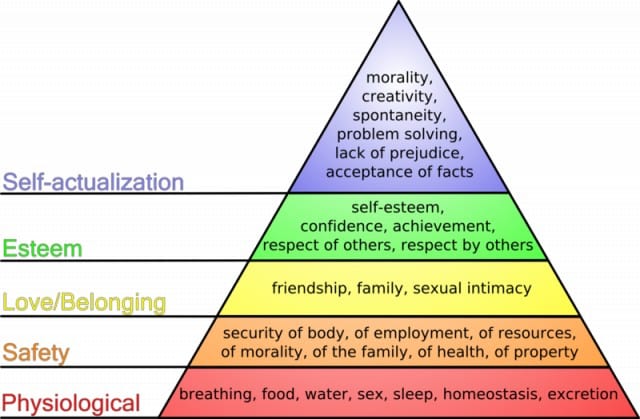From Wikipedia (shortened and slightly modified version of the original text)
Maslow's Hierarchy of Needs is a theory in psychology that Abraham Maslow proposed in his 1943 paper A Theory of Human Motivation, which he subsequently extended. His theory contends that as humans meet 'basic needs', they seek to satisfy successively 'higher needs' that occupy a set hierarchy. Maslow studied exemplary people such as Albert Einstein, Jane Addams, Eleanor Roosevelt, and Frederick Douglass rather than mentally ill or neurotic people, writing that "the study of crippled, stunted, immature, and unhealthy specimens can yield only a cripple psychology and a cripple philosophy." (Motivation and Personality, 1987)

This diagram shows Maslow's hierarchy of needs, represented as a pyramid with the more primitive needs at the bottom.
Maslow's hierarchy of needs is often depicted as a pyramid consisting of five levels: the four lower levels are grouped together as deficiency needs associated with physiological needs, while the top level is termed growth needs associated with psychological needs. While deficiency needs must be met, growth needs are continually shaping behaviour. The basic concept is that the higher needs in this hierarchy only come into focus once all the needs that are lower down in the pyramid are mainly or entirely satisfied. Growth forces create upward movement in the hierarchy, whereas regressive forces push prepotent needs further down the hierarchy.
At the top of the triangle, self-transcendence is also sometimes referred to as spiritual needs .
Maslow believes that we should study and cultivate peak experiences as a way of providing a route to achieve personal growth , integration, and fulfillment. Peak experiences are unifying, and ego-transcending, bringing a sense of purpose to the individual and a sense of integration. Individuals most likely to have peak experiences are self-actualized, mature, healthy, and self-fulfilled. All individuals are capable of peak experiences. Those who do not have them somehow depress or deny them.
Maslow originally found the occurrence of peak experiences in individuals who were self-actualized, but later found that peak experiences happened to non-actualizers as well but not as often. In his The Farther Reaches of Human Nature (New York, 1971) he writes:
"I have recently found it more and more useful to differentiate between two kinds of self-actualizing people, those who were clearly healthy, but with little or no experiences of transcendence, and those in whom transcendent experiencing was important and even central … It is unfortunate that I can no longer be theoretically neat at this level. I find not only self-actualizing persons who transcend, but also nonhealthy people, non-self-actualizers who have important transcendent experiences. It seems to me that I have found some degree of transcendence in many people other than self-actualizing ones as I have defined this term …"
You can find our interpretations of the needs of human beings at the following places:
Hierarchy in objectives of life
From the above mentioned maslow hierarchy of needs, we develop goals and objectives.
In the above context, it might make sense to have a look at the following discussions about the objectives of life . We have devoted to them a whole chapter in our book.
Comments are closed.